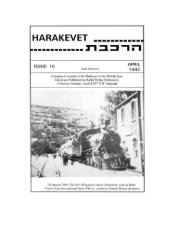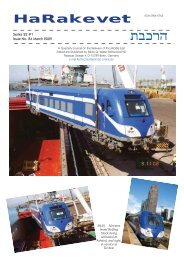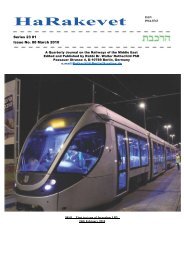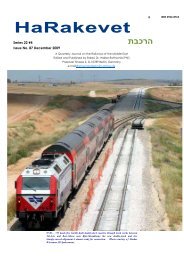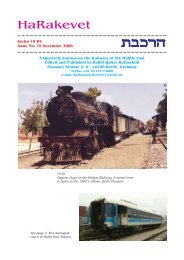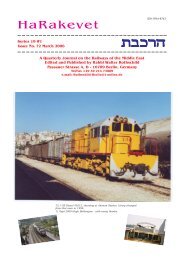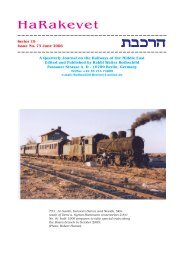You also want an ePaper? Increase the reach of your titles
YUMPU automatically turns print PDFs into web optimized ePapers that Google loves.
e convinced and which is judging the SNCF.<br />
And so, three and a half years after the Bordeaux<br />
ruling, Pépy announced his deep regret<br />
- albeit with the rider that the repentance<br />
is for deeds which were performed under<br />
pressure from the German occupiers. It is<br />
unclear whether David Harris and the other<br />
Jewish representative organisations will be<br />
satisfied with such a ‘Yes, but...’ response.”<br />
In Germany the emotions are<br />
screwed up even higher. A leaflet was distributed<br />
with the Jewish weekly newspaper<br />
in November 2010 by the ‚Train of Remembrance‘<br />
organisation (www.zug-der-erinnerung.eu).<br />
The ‘ZUG DER ERINNERUNG’ leaflet reads (in<br />
excerpts):-<br />
“The Deutsche Bahn AG has been<br />
celebrating station festivals for months, to<br />
mark 175 Years of German Railways. The high<br />
point will be a major ceremony with the<br />
Bundeskanzlerin in Nürnberg in early December.<br />
For several thousand people, who<br />
experienced the German railway system in a<br />
tragic manner between 1933 and 1945, such<br />
festivities are inacceptable. These people<br />
are survivors of the mass deportations performed<br />
by the predecessor of the DBAG, the<br />
Deutsche Reichsbahn.<br />
The ‘Reichsbahn’ dragged its victims<br />
all over Europe into Forced Labour or Extermination<br />
Camps. There were millions, including<br />
uncounted children and young people.<br />
Those being deported had to pay for their<br />
journey to death themselves; the ‘Reichsbahn’<br />
charged fares for the special trains<br />
to Auschwitz. The ‘Reichsbahn’ wagons returned<br />
filled with the booty plundered from<br />
the dead. Without the German railway system<br />
it would have been impossible to carry out<br />
the mass murder, which also brought economic<br />
benefits, on this scale.<br />
The last survivors of the ‘Reichsbahn’<br />
crimes have deserved that they should<br />
be recompensed. After a lifetime of damage<br />
due to the deportation and their lives as<br />
slaves, it should be automatically understood<br />
that in their old age they should be able to<br />
live without financial worries. But the ‘Reichsbahn’<br />
heirs refuse; the DBAG and the German<br />
Government refuse to pay compensation to<br />
the deportation victims of the ‘Reichsbahn’.<br />
Instead they are fobbed off with ‘Help Projects’<br />
in Eastern Europe, at a rate of about €25<br />
per person. The DBAG is turning its victims<br />
into beggars. The helplessness of the weakened<br />
and impoverished survivors of Auschwitz<br />
is being misused.<br />
This is the same concern which<br />
currently earns billions. As the plans for the<br />
massive construction project in Stuttgart illustrate,<br />
the ‘Reichsbahn’ heirs have enough<br />
money to invest in controversial future projects.<br />
But how far is the DBAG really oriented<br />
towards the future, when it does not want<br />
to remember the blame attached to German<br />
railway system? ....................<br />
The NS victims travelled at least 48<br />
hours in their sealed wagions to the camps.<br />
The deportees had to pay their own fares<br />
- half price for children. The Reichsbahn offered<br />
a discount towards groups of of 400<br />
persons or more - and never paid any of the<br />
money back.<br />
Instead of proper compensation<br />
the DBAG is offering survivors meagre sums<br />
- the ca. 200,000 ‘Reichsbahn’ victims in Eastern<br />
Erope are being offered single payments<br />
of €25. Due to the short-term collapse of the<br />
air-conditioning system in trains, the DBAG<br />
paid those affected €500 last summer; 48<br />
hours of deathly terror on German rails seems<br />
to be worth only €25....”<br />
The leaflet is illustrated with photos<br />
of children who were deported, and of the<br />
DR electric E19 loco at Nürnberg Museum. It<br />
concludes by calling for a mass demonstration<br />
at Nürnberg Hbf. on 4th. December.<br />
[Editor comments - a Very emotional<br />
appeal, which also mixes up the extermination<br />
trains (from which, naturally enough,<br />
there were very few survivors) and the trains<br />
of ‘Zwangsarbeiter’ from Eastern Europe, of<br />
whom many remain.]<br />
(k). OBITUARY: GEORGE BEHREND.<br />
1922 - 2010.<br />
From ‘Today’s Railways Europe’ No.<br />
179 (Nov. 2010) p.19:-<br />
Railway writer and historian George<br />
Behrend died on 12th. July at the age of 88. “An<br />
expert on Pullman and Wagon-Lit cars, Behrend<br />
wrote several books on these and many other<br />
railway-related topics... Born at Burghclere,<br />
Hampshire, he lived on Jersey from 1956 to<br />
1989 and then in Findochty, north-east Scotland.<br />
During his time there he was a supporter of the<br />
Keith-Dufftown railway and helped to bring two<br />
Pullman cars and original Pullman crockery to the<br />
line. His wife, Jeanette D’Eyer, died in 1992. They<br />
had no children. He continued to make one trip<br />
abroad each year while his health permitted, his<br />
favourite being the Orient Express to Venezia.<br />
He also travelled all the way from his home to<br />
Penzance, Cornwall using sleeper trains on two<br />
consecutive nights on one occasion: from Inverness<br />
to London one night and then from London<br />
to Penzance the following night. Deteriorating<br />
health finally led to him moving into a nursing<br />
home in Cullen in early 2009. Behrend had an<br />
extensive knowledge of rolling stock throughout<br />
Europe and often received calls requesting the<br />
number of a particular vehicle. If he did not know<br />
the answer offhand, he would know where to<br />
find it in his vast collection of information. It is understood<br />
that some of his archive will now go to<br />
the Wagons-Lits Society.”<br />
[The Editor adds: I read ‘Gone With<br />
Regret’, his homage to the Great Western Railway,<br />
several times in my youth. But it was years later<br />
that we made contact and I recall friendly and<br />
helpful and supportive letters - also on Sleeping<br />
and Dining Cars in Egypt and on Palestine Railways<br />
- at a time when these things are by no means<br />
automatic. These notes then appeared in ‘Harakevet’.]<br />
<strong>91</strong>:08.<br />
A. IRAN.<br />
(i). CHINA LINK.<br />
From ‘Telegraph.co.uk’ 07.09.2010,<br />
by Malcolm Moore. “China is poised to sign<br />
a $2 Billion (GBP1.3 Bn) deal to build a railway<br />
line in Iran in the first step of a wider plan to<br />
tie the Middle East and Central Asia to Beijing.<br />
China’s railways minister, Liu Zhijun,<br />
is expected to visit Tehran this week to seal<br />
the deal, according to his Iranian counterpart,<br />
Hamid Behbahani. ‘The final document of the<br />
contract has already been signed with a Chinese<br />
company and the Chinese minister will<br />
visit Iran on September 12 to ink the agreement’,<br />
said Mr. Behbahani.<br />
The new line will run from Tehran<br />
to the town of Khosravi on the border with<br />
OTHER MIDDLE EAST RAILWAYS.<br />
Iraq, around 360 miles as the crow flies,<br />
passing through Arak, Hamedan and Kermanshah.<br />
Eventually, the Iranian government said,<br />
the route could link Iran with Iraq and even<br />
Syria as part of a Middle-Eastern corrdor. That<br />
could also benefit the 5,000 Iranians who<br />
make pilgrimages each day to the holy cities<br />
of Najaf and Karbala in Iraq.<br />
Nicklas Swanstrom, the executive<br />
director of the Central Asia-Caucasus Institute<br />
at John Hopkins University, said the contract<br />
to build the line was the first step for China<br />
to build an entire rail infrastructure for central<br />
Asia. ‘It makes sense that if you build railways<br />
in Iran, you then get deals to stretch the<br />
lines into central Asia’, he said, referring to a<br />
,cfrv<br />
‘very concrete plan’ to run a railway from Iran<br />
through the landlocked countries of Tajikistan,<br />
Kyrgyzstan and eventually to Kashghar in China,<br />
in a modern ‘silk route’.<br />
The line would give the central<br />
Asian states vital access to Iran’s ports of<br />
Chahbahar on the shores of the Persian Gulf.<br />
‘For China, it would cut the cost of transporting<br />
goods to Europe by 5-6%’, said Professor<br />
Swanstrom. ‘It also makes political sense,<br />
because while technically the US, Europe<br />
or Russia could block China’s sea routes, it<br />
would also have a land route. And by tying<br />
your neighbour’s infrastructure to you, it<br />
brings them closer’, he added. ‘It decreases<br />
Russia’s influence in the region, and definitely<br />
Page 19



